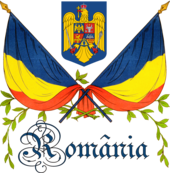| This article is part of a series on |
| Symbols of Romania |
|---|
 |
The colors of the national flag of Romania (Romanian: Drapelul României) has a long history, though the association of the three colors only dates to the 18th century. Red, yellow and blue were found on late 16th-century royal grants of Michael the Brave, as well as shields and banners.[1] Thus, the late 13th century Wijnbergen armorial shows the coat of arms of the Wallachian ruler Litovoi as consisting of a shield of ten vertically alternating gold-and-red bands.[2][3][4] The same two colors, gules and or, also appeared on the late 15th century flag and coat of arms of Moldavia, during the reign of Stephen the Great.[5] Then, from the late 16th century until the mid-17th century, the historical coat of arms of Transylvania gradually developed as a shield party per fess, consisting of a black eagle on blue background in the upper field, a dividing red band in the middle, and seven red towers on golden background in the lower field.[6][7] Finally, in the last quarter of the 18th century, Bukovina gets its own coat of arms from the Habsburg Empire, a blue-and-red shield party per pale with a black aurochs' head in the middle, and three golden six-pointed stars surrounding it.[3] During the Wallachian uprising of 1821, these three colors were present, along others, on the canvas of the revolutionaries' flag and its fringes; for the first time a meaning was attributed to them: "Liberty (blue-sky), Justice (yellow field), Fraternity ( blood)".[8]
- ^ Pălănceanu, p. 138
- ^ Dogaru, Maria, "Stema voievodului Litovoi", in Magazin istoric, XIX, 10, pp. 6–7.
- ^ a b Dogaru, Maria, "Din heraldica României", Ed. Jif, Brașov, 1994.
- ^ Mănescu, Jean N., "Cu privire la originea stemei Țării Românești", in "Cercetări numismatice", V, 1983, pp. 185–189.
- ^ "Principality of Moldavia".
- ^ Cernovodeanu, Dan, "Știința și arta heraldică în România", Bucharest, 1977, p. 130.
- ^ von Straussenburg, Albert Arz; Hienz, Hermann Adolf; Herter, Balduin: "Beiträge zur siebenbürgischen Wappenkunde", p. 184.
- ^ Iscru, Gheorghe D., "Steagul Revoluției din 1821", in Revista Arhivelor nr. 2/1981, p. 211